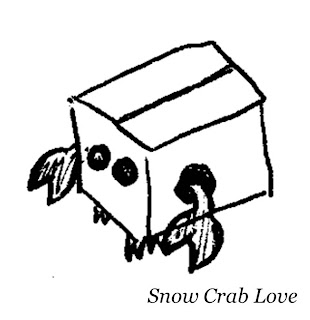My friend Gretchen (harbor seal chick!) sent me this cartoon and I thought it was so funny and perfect as an opener to show just how cute hermit crabs can be. So here you go, crab lovers, it's hermit Crabday!!
There are SO MANY hermit crab species out there, it's kind of hard to know where to start. But you've already met one beautiful hermit crab from our first Crabday: the coconut crab! Remember, coconut crabs (Birgus latro) give up the extra protection around their abdomen after adolescence. Then they just rock out with their... soft abdomen out. Yes.
You see, most hermit crabs you know and love need shells because of this feature:
The hermit crab's soft abdomen spirals perfectly to fit inside a
snail shell, as you can see with this guy in the glass shell.
Guess he won't be throwing rocks any time soon, you know what I mean?
If you're like me, you're probably wondering how they mate with all that shell in the way. Male and female hermit crab anatomy is pretty similar to snow crabs, but for males to successfully copulate with female hermit crabs, all they have to do is give a little knock-knock (who's there?) and rock the shell, literally, to convince the female to come out of her protective home. Then BAM!
So, with all that out of the way, here are the cuties I promised:
here's a little Alaskan guy I found in my rocky intertidal backyard - Pagurus sp.
(read about hermit crabs in Alaskan seabird diets here)
"EEEE, I'm a tiny hermit crab!"
I love how comically large the shell is for this beautiful blue hermit crab
hermit crab: "Need a lift?"
anemone: "I got your back, bro."
TGIC, am I right?



































